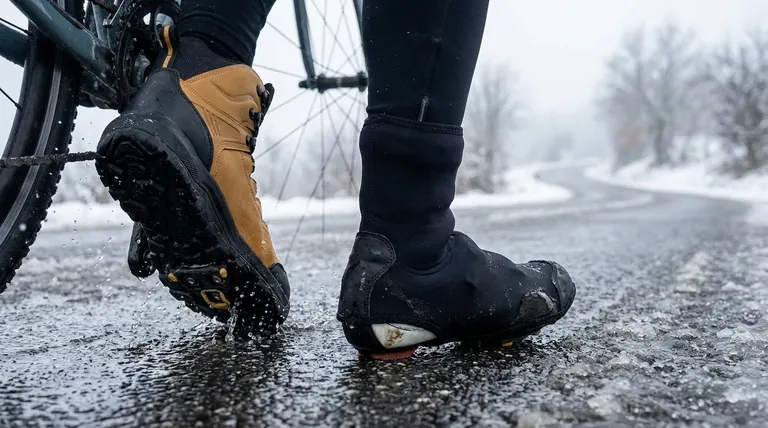The primary advantages of dedicated winter cycling boots are superior warmth, convenience, and long-term durability when compared to using standard shoes with overshoes. They are a purpose-built system designed to combat cold and wet conditions without the compromises inherent in an add-on accessory.
While overshoes offer a low-cost entry point for warmth, dedicated winter cycling boots provide a more reliable, convenient, and ultimately more effective solution. The choice is between a temporary fix and a purpose-built piece of equipment.

The Core Difference: An Integrated System
The fundamental advantage of a winter boot is that it's designed from the ground up as a single, cohesive unit to protect your feet. An overshoe is an accessory layered on top of a shoe designed for warm weather.
Purpose-Built for Warmth and Weatherproofing
A dedicated winter boot integrates insulation and a waterproof membrane directly into its construction. This eliminates the gaps and vulnerabilities that allow cold air and water to penetrate a shoe/overshoe combination.
The ankle cuff is also typically higher and better sealed, providing crucial protection against wind and road spray.
Seamless Integration with Your Pedals
Winter boots have a standard outsole with a clean, unobstructed channel for your cleats. This ensures consistent and easy clipping in and out of your pedals.
Overshoes, with their universal fit, often interfere with the cleat and pedal mechanism, leading to fumbling and frustration.
Unrestricted Access to Adjustments
Because there is no outer layer covering the shoe, you retain full access to your boot's closure system, like Boa dials or straps. This allows you to make micro-adjustments to the fit mid-ride, a feature completely blocked by overshoes.
A Practical Comparison of Daily Use
Beyond technical specifications, the day-to-day experience highlights the practical superiority of dedicated boots for regular winter riders.
The Convenience Factor
Putting on and taking off winter boots is as simple as any other shoe. In contrast, wrestling with tight, often dirty neoprene overshoes with cold fingers before and after a ride is a significant hassle.
Off-Bike Durability and Function
Winter boots are made to be walked in, featuring robust soles. Overshoes are notoriously fragile and can easily rip or wear out from just a few short walks at a cafe stop or during a roadside repair.
Understanding the Trade-offs
To make an informed decision, you must weigh the upfront cost against the long-term benefits and performance compromises.
The Initial Financial Investment
Dedicated winter boots represent a significant upfront cost compared to a pair of overshoes. This is the primary advantage of the overshoe solution.
The Long-Term Value Proposition
Overshoes typically last only one season of consistent use before they tear or lose effectiveness. A quality pair of winter boots can last three to four winters, making them the more cost-effective choice over time.
The Limits of Overshoes
Overshoes are a compromise. They add bulk, can make clipping in difficult, and prevent on-the-fly fit adjustments. While they provide insulation, they are rarely as warm or waterproof as an integrated boot.
The Bike Fit Consideration
Using overshoes allows you to continue using your perfectly dialed-in summer shoes, requiring no changes to your bike fit. Switching to a different pair of shoes, like winter boots, may require minor adjustments to your saddle height or cleat position.
Making the Right Choice for Your Riding
Your decision should be based on your budget, how frequently you ride in the cold, and your tolerance for inconvenience.
- If your primary focus is maximum warmth and convenience: Dedicated winter boots are the definitive choice for any cyclist serious about riding through the winter.
- If your primary focus is budget or you ride infrequently in the cold: Overshoes provide a cost-effective way to extend your season using your existing gear.
- If you face truly extreme cold or wet conditions: Some riders find success using overshoes over their winter boots as the ultimate defense against the elements.
Investing in the right foot protection transforms winter cycling from a battle for survival into a season you can genuinely enjoy.
Summary Table:
| Feature | Winter Boots | Shoes + Overshoes |
|---|---|---|
| Warmth & Weatherproofing | Integrated, superior protection | Layered, potential for gaps |
| Convenience | Easy on/off, full access to adjustments | Difficult to put on/take off |
| Durability | Built to last multiple seasons | Often lasts only one season |
| Pedal Integration | Unobstructed, consistent clipping | Can interfere with cleats |
| Off-Bike Use | Robust soles for walking | Fragile, easily damaged |
Ready to Enjoy Winter Riding with the Right Footwear?
As a large-scale manufacturer, 3515 produces a comprehensive range of high-performance footwear for distributors, brand owners, and bulk clients. Our production capabilities encompass all types of shoes and boots, including purpose-built winter cycling footwear designed for superior warmth, durability, and rider convenience.
Let us help you equip your customers for the season. Contact our team today to discuss your production needs and discover the 3515 advantage.
Visual Guide

Related Products
- Premium Insulated Safety Boots and Shoes for Wholesale & Bulk Orders
- High Performance Fire-Retardant Waterproof Safety Boots
- Safety Footwear Wholesale Manufacturer for Custom OEM/ODM Production
- Premium High-Cut Waterproof Safety Boots Manufacturing & Wholesale Solutions
- Premium Wholesale Waterproof Safety Boots High Performance Protection for Industrial Markets
People Also Ask
- Can insulated work boots be worn in warmer weather? Avoid Discomfort and Foot Health Risks
- What is the best way to protect feet from frostbite in winter? A Complete System for Dry, Warm Feet
- What features should one look for when selecting supportive winter footwear? Secure Your Stride with the Right Support
- What additional protective footwear feature might be beneficial for construction workers in cold climates? Choose Composite Toe for Superior Warmth
- Why is keeping feet warm important during winter work? Protect Your Health and Safety on the Job



















